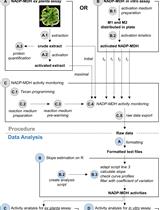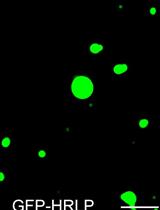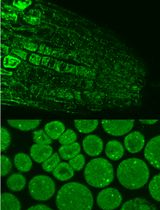- EN - English
- CN - 中文
An in vitro Coupled Assay for PEPC with Control of Bicarbonate Concentration
一种控制碳酸氢盐浓度的磷酸烯醇式丙酮酸羧化酶的体外偶联分析
发布: 2021年12月20日第11卷第24期 DOI: 10.21769/BioProtoc.4264 浏览次数: 2704
评审: Shuhei OtaAli ParsaeimehrSteven James Burgess
Abstract
Phosphoenolpyruvate carboxylase (PEPC) catalyzes a critical step in carbon metabolism in plants and bacteria, the irreversible reaction between bicarbonate and phosphoenolpyruvate to produce the C4 compound oxaloacetate. This enzyme is particularly important in the context of C4 photosynthesis, where it is the initial carbon-fixing enzyme. Many studies have used kinetic approaches to characterize the properties of PEPCs from different species, different post-translational states, and after mutagenesis. Most of these studies have worked at a fixed saturating concentration of bicarbonate. Controlling the concentration of bicarbonate is difficult at low concentrations because of equilibration with atmospheric CO2. We describe here a simple, repeatable, and gas-tight assay system for PEPC that allows bicarbonate concentrations to be controlled above ca. 50 µM.
Background
The enzyme phosphoenolpyruvate carboxylase (PEPC; E.C. 4.1.1.31) catalyzes the essentially irreversible reaction between bicarbonate and phosphoenolpyruvate (PEP) to form oxaloacetate and inorganic phosphate. This reaction is a critical step in carbon metabolism in plants and bacteria, but the enzyme is most widely studied in the context of its critical role in C4 photosynthesis, where it is responsible for primary carbon fixation. In typical PEPC assays, the enzyme is coupled to malate dehydrogenase (MDH), which converts oxaloacetate to malate, consuming NADH, and leading to a decrease in absorbance at 340 nm. This reliable coupled assay has been used extensively to compare PEPCs from different species and to understand the consequences of post-translational modification on inhibitor binding and affinity for PEP (Janc et al., 1992; Duff et al., 1995; Blasing et al., 2000; Jacobs et al., 2008; Paulus et al., 2013). Studies where the concentration of bicarbonate is varied are more challenging, as background bicarbonate, arising from equilibration with atmospheric CO2, is found at concentrations above the Km for bicarbonate (often less than 100 µM), preventing accurate kinetic measurements. Measuring the rate of the PEPC reaction at low bicarbonate concentrations requires that background bicarbonate be removed as much as possible, and careful gas-tight assay procedures. Accurate kinetic measurements also require determining the concentration of residual bicarbonate, allowing calculation of the correct concentration of substrate.
We describe here a set of methods to remove most background bicarbonate, quantify the remaining amount, and reliably assay the enzyme without significant contamination from atmospheric CO2. Using these methods, we can reliably reduce background bicarbonate to less than 50 µM.
Overview: The methods described here are simple and repeatable. The major assay components, buffer and water, are sparged with nitrogen gas to reduce the background bicarbonate concentration. Assays are constructed and sealed under nitrogen to minimize contamination from atmospheric carbon dioxide. Assays are then initiated by the addition of PEPC, delivered with a gastight syringe. Background bicarbonate is determined using an endpoint assay.
Limitations: While we have found these methods suitable for measuring the properties of a wide range of PEPC enzymes (Bauwe, 1986; Phansopa et al., 2020), they are not universally applicable. For PEPC enzymes with Kmbicarbonate much below the residual background bicarbonate, the experimental design and data analysis described here are not suitable, so an alternative approach using the integrated Michaelis-Menten equation is recommended. This alternative approach requires additional controls to overcome problems associated with product inhibition, enzyme instability, and product instability leading to regeneration of CO2 in solution; these are not described here and the interested reader should consult the careful work of Bauwe (1986), and DiMario and Cousins (2019).
Also, as the product oxaloacetate is converted into malate in the assay described here, it is not possible to carry out product inhibition studies using oxaloacetate. This limitation could be resolved by detecting a substrate or the other product. An elegant alternative detection system for gaseous CO2, coupled to the substrate concentration through carbonic anhydrase, has been described using membrane-inlet mass spectrometry (DiMario and Cousins, 2019). Our attempts to develop an alternative assay to monitor the production of inorganic phosphate using the purine nucleotide phosphorylase assay (Webb, 1992) were unsuccessful, due to inhibition of PEPC by components of the coupling system (unpublished work).
Materials and Reagents
Pipette tips
0.2 µm pore filter
1.5 ml mini-centrifuge tubes (Eppendorf, catalog number: 0030120159)
0.5 ml sealable UV-Cuvette (Fisher Scientific, catalog number: 10386712)
Whatman membrane filters, nylon pore size 0.2 μm, diameter 47 mm (Millipore Sigma, catalog number: WHA7402004)
Parafilm (Bemis, catalog number: 11772644)
Two rubber septa for ST/NS 24/40 joint (Millipore Sigma, catalog number: Z553980)
Two glass stoppers for ST/NS 24/40 joint (Millipore Sigma, catalog number: Z229571)
12.5 mm rubber septa for sealing cuvettes (Millipore Sigma, catalog number: Z167274)
Three pieces of 1 m long 4 mm bore rubber tubing (Fisher Scientific, catalog number: 11876293)
A glass funnel
Two 5 ml syringes (Terumo, catalog number: Z116866)
Two 120 mm, 21-gauge needles (Sterican, catalog number: 466 5643)
Two 40 mm, 21-gauge small needles (BD Microlance 3, catalog number: 304432)
PEPC Enzyme: Wild type or mutant PEPC purified from E. coli, stored at -80°C
Phosphoenolpyruvate trisodium salt (PEP, Millipore Sigma, catalog number: P7002), store at -20°C
Malate dehydrogenase enzyme (MDH, Millipore Sigma, catalog number: M2634), store at 4°C
β-Nicotinamide adenine dinucleotide (NADH, Millipore Sigma, catalog number: 10107735001), store at -20°C
Magnesium chloride (MgCl2, Millipore Sigma, catalog number: 63069)
Potassium bicarbonate (KHCO3, Millipore Sigma, catalog number: 60339)
Tricine (Millipore Sigma, catalog number: T0377)
Tris(hydroxymethyl)aminomethane (Tris base) (Millipore Sigma, catalog number: 252859)
Potassium chloride (KCl, Millipore Sigma, catalog number: T0377)
Potassium hydroxide (KOH, Millipore Sigma, catalog number: 757551)
Ultrapure deionised water
Tris-HCl (see Recipes)
Tricine-KOH (see Recipes)
Equipment
Pipettes
1700 series gastight syringe with a cemented needle (Hamilton, catalog number: 80200)
Nitrogen gas supply
Nitrogen gas canister (99.998% minimum N2, BOC, catalog number: 44-W)
Two 250 ml two-neck round bottom flasks (Millipore Sigma, catalog number: Z516872)
Glass single bank manifold with three positions (Millipore Sigma, catalog number: Z532169)
Magnetic stirrers
Magnetic stirrer plate
A split-beam spectrophotometer with temperature control. For example, a Cary 300 UV-Vis spectrophotometer (Agilent). A cell changer is not essential but it is convenient.
Software
Cary WinUV software (Agilent, www.agilent.com)
Igor Pro (Version 7.0.8.1; Wavemetrics Inc., Lake Oswego, Oregon, www.wavemetrics.com) or equivalent package capable of non-linear regression analysis.
Procedure
文章信息
版权信息
© 2021 The Authors; exclusive licensee Bio-protocol LLC.
如何引用
Moody, N. R., Phansopal, C. and Reid, J. D. (2021). An in vitro Coupled Assay for PEPC with Control of Bicarbonate Concentration . Bio-protocol 11(24): e4264. DOI: 10.21769/BioProtoc.4264.
分类
植物科学 > 植物生物化学 > 蛋白质 > 活性
生物化学 > 蛋白质 > 活性
您对这篇实验方法有问题吗?
在此处发布您的问题,我们将邀请本文作者来回答。同时,我们会将您的问题发布到Bio-protocol Exchange,以便寻求社区成员的帮助。
Share
Bluesky
X
Copy link













